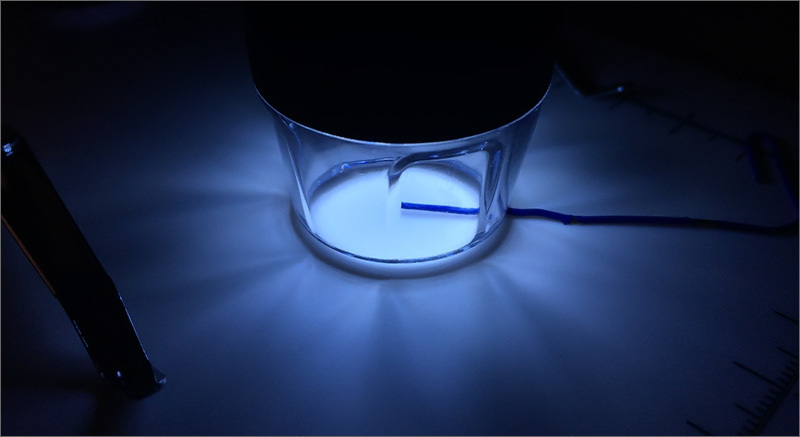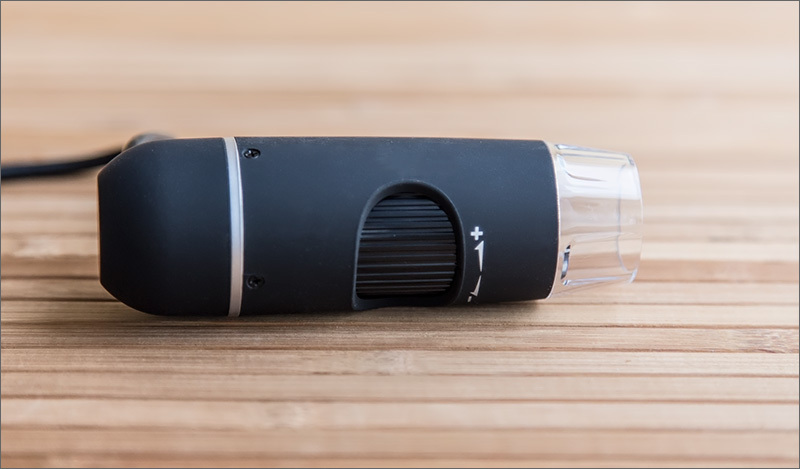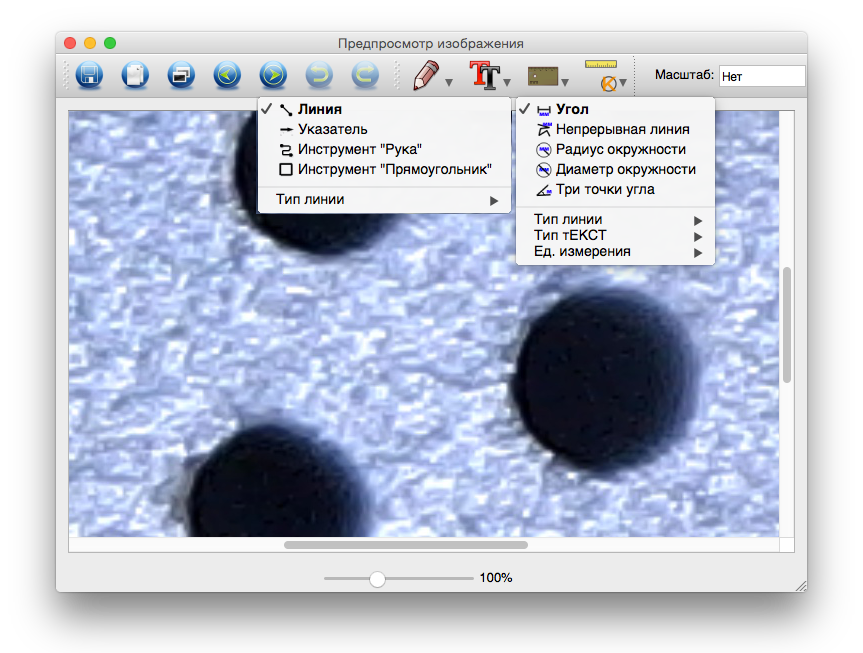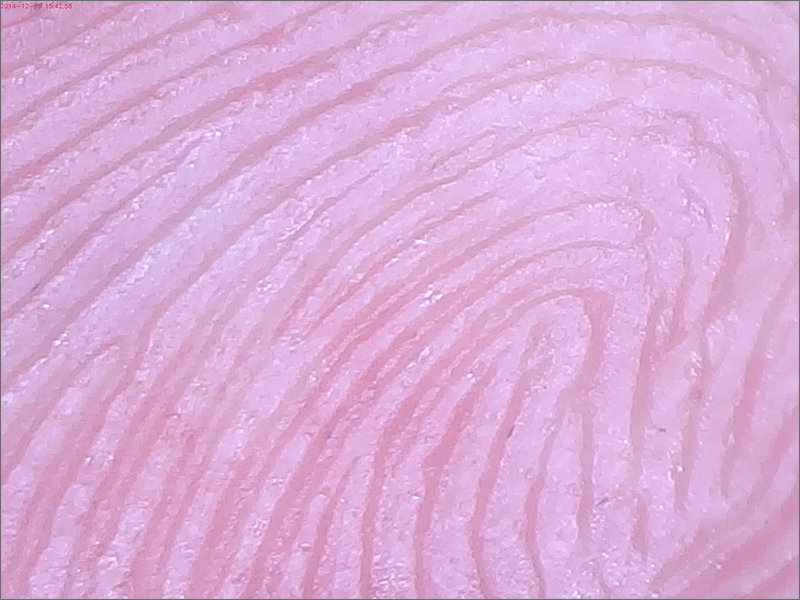Levenhuk DTX90 USB Digital Microscope Review
Today we will talk about such an indispensable thing in the economy as a microscope. Can you name at least 3-4 microscope manufacturers? That's the same, these are not smartphones or cameras for you. Moreover - today our guest is not a simple microscope, but a golden digital one: which you can connect to a computer and watch everything through it. Caution! Fasting can cause an irresistible desire to buy a microscope.
The name of the protagonist of today's review is the Levenhuk DTX90 . It is surprising that there is not a single mention of this brand on Geektimes, although it is Russian, it has existed since 2002 and it has a rather extensive model range of not only microscopes, but also other optical devices: binoculars, monoculars, telescopes, magnifiers, etc.

The manufacturer positions the Levenhuk DTX90 as a professional digital USB microscope for ultra-precise work.
The device is sold in an inconspicuous white-green box inside which there are in polyethylene thicknesses:

- Microscope
- Subject table
- Tripod
- Instructions and software disc
- Calibration scale

Outwardly, the “microscope” itself reminds me of a flashlight that is mounted on the steering wheel of my bicycle - it’s like that the same form, also has a soft touch coating and a pack of LEDs inside. But the similarities end there.
So, the Levenhuk DTX90 digital microscope consists of three parts:
Stand . This is both the support of the whole structure, and the subject table, on which you will consider all sorts of things.

From the bottom, she has 4 rubberized legs that prevent the device from sliding on the table, from the top, two movable clamps and a white matte surface, the working area of which is 7x8 cm (according to the applied scales).

The clamps are metal and rotate 360 degrees, but are not removable. Also in the upper part is the nut that secures the tripod to the subject table.

Tripod . L-shaped design, which is inserted into the anchor mount of the stand. The leg itself is a metal tube, however, the second part of the tripod is made of plastic (very high quality and pleasant to the touch).

There are three controls on the plastic part of the tripod: the coarse focus wheel (fixes the plastic part on a metal tube to raise the microscope higher or lower), the fine adjustment wheel (raises and lowers the microscope more smoothly) and the locking screw of the moving part of the tripod.

Another latch is located in the mount on the “boom” of the tripod, where the microscope itself is fixed.

Microscope . All optics are hidden in a plastic case, at the bottom of which there are 8 LEDs. There is also a small cutout in which the microscope focal length adjuster is located.


A USB cable comes from the microscope, which, if desired, can be mounted in a tripod. By the way, there is a small remote control on the wire with a dimmer for LEDs and a button for creating a photo (unfortunately, it only works on Windows).

The design is extremely convenient - it allows you to look at something in a strictly fixed position (the microscope above the stand), and somewhere off to the side (if you turn the L-shaped tripod to the other side). You can also hold the microscope itself in your hands to climb into hard-to-reach places.

But at the same time, the device lacks solidity - the stand is not very heavy, so even with a smooth focus adjustment, the microscope shakes a little.
The application for working with a microscope can be taken not only on the CD from the kit, but also from the manufacturer’s website. It is noteworthy that the Download link downloads a 32MB archive, inside which are the electronic version of the instruction and the application itself for both platforms (Windows and OS X).

Immediately after starting the application and connecting the microscope via the USB interface, an enlarged image appears on the screen - in real time, without any delay. Looking ahead is very convenient. If you need not just to look at some objects, but to study the sizes of their fragments, then you need to calibrate the device using the calibration scale from the kit (the process takes a couple of clicks).
The application allows you to take photos (in resolution 1.3, 2, 3 or 5 megapixels - 1280x960, 1600x1200, 2048x1536 or 2592x1944) and record video (1280x960, in * .avi format) of what is located on the "operating table". So if there is a desire to take a printed photograph and put on the table a photo card of the form “Sugar scatter - take a picture of it while it was lying” - you will succeed, the camera’s capabilities are quite enough for this. Optionally, you can superimpose the shooting date and time on the image (data are taken from the system), and also take various actions with the photos in the built-in editor: take all kinds of measurements (distances, angles, radii, perimeter), mark, arrows, text, and so on . There is a full-screen mode and 12 interface languages (including Russian).

Unfortunately, the application does not work without a connected microscope.
At first, the microscope was fixed in the upper position of the tripod, and I was even a little upset that it would not be possible to examine anything in the smallest details - the old grandfather’s binocular even saw more. But how is it that the 300x zoom is written on the box! But it turned out that you just had to lower the microscope module :) Despite the fact that the real optical magnification is 10-60 times (300x zoom is an olivier from interpolation and marketing), the microscope allows you to see quite interesting and scary things from the outside world, on which previously did not pay attention. Built-in LEDs sometimes interfere with viewing reflective surfaces, but you quickly get used to it (especially since they can be completely turned off by lighting the subject table with any other light source).











I have grouped a series of shots taken by the device: look and guess.
6 different fiber rags for cleaning equipment: The manufacturer claims that this is a carbon case for a smartphone. Carbon after all? :) Clerical knife blade: Money: coins, microtext on a bill, a holographic element, a guy’s pipette from 100 rubles and a protective metal tape. Something from the iPhone and MacBook: frayed hard disk cable, earpiece, microphone holes, contacts and display. Guess where? Retina and not Retina. On the non-Retina display, a matte film is glued. Also note how much garbage is in the basket :)











































Auchan parking, CD, sleeve, earphone, microcircuit, microSD card, pencil, pen ink, pin, SIM card and the inscription on it: Contact lens:













The most difficult thing: try to guess what is in the photo: These are not all the horrors of the world that I happened to know over the weekend - I immediately deleted something, decided not to put something in the name of your healthy psyche. But, believe me, having such a thing, you will want to consider everything in a row through it: this is how to regain sight. All the objects around you will be under the optics of the device on the first day: all gadgets, body parts, food and everything else - you will eagerly watch, watch and watch. You will not see ciliates, amoebas, and other Higgs bosons, but you still get a lot of pleasure from interfering in the world of this scale.



I repeat once again: the form factor of the device is extremely successful - if something does not fit on the stage, then you can bring the microscope to it and see the plan anyway. In the lineup there is an even more convenient formator - the DTX 500 Mobi model with an integrated display and battery (so that you do not have to connect a laptop).
Unfortunately, the available approximation of this device does not allow you to make an interesting guessing game - everything is guessed quite easily. Therefore, let's try to do it the next time - there was an irresistible desire to take some more advanced microscope, possibly also a digital one, for testing.
+ USB connection, the ability to take photos and videos
+ Ease and convenience of work
+ Adjustable backlight
+ Availability of software for Windows and OS X
+ Small price
- Small "workspace"
- Not very convenient image clarity
The manufacturer’s recommended retail price for the microscope is 4,990 rubles - Exactly how much it costs in the Ulmart store (at the time of writing). I think that this is not very much - for comparison, the same cost are good webcams from some Logitech (by the way, the principle of operation of the devices is partially similar).
Also available are two younger models and two older ones:
- DTX 30(magnification 20–230x, camera 2 megapixels) - 3390р
- DTX 50 (magnification 20–400x, camera 1.3 megapixels) - 3790r
- DTX 500 Mobi (magnification 20–500x, camera 5 megapixels, portable) - 8390р
- DTX 500 LCD ( 20-500x magnification, 5 megapixel camera, built-in display) - 9950r
Personally, from the word “microscope” in my mind I see frames from all kinds of films and television shows, where scientists in gauze bandages examine the structure of the processor at the atomic level. Unfortunately, Levenhuk DTX90 does not provide an approximation sufficient to examine even the Ebola virus and other delights of the microworld. Nevertheless, it is enough to solve so many other problems - a convenient form factor will only contribute to this.
Also, the device is ideal for schoolchildren and students for all kinds of educational purposes, although in this regard, they may be more suitable for a device with a larger magnification.

The manufacturer positions the Levenhuk DTX90 as a professional digital USB microscope for ultra-precise work.
Specifications
Camera resolution: 5 Mpix
Zoom: 10x – 300x
Available resolutions: 2592x1944, 2048x1536, 1600x1200, 1280x960
Video recording resolution: 1280x960
Photo / video: * .jpeg / *. Avi
Focus: Manual, from 0 mm to 150 mm
Lighting source : 8 LEDs with adjustable system brightness
Power: 5V DC via USB cable
Software Languages: English, German, Spanish, Russian, Italian, French, Portuguese, Dutch, Polish, Japanese, Korean, Chinese
Microscope Dimensions (L x ⌀): 110 mm x 33 mm
Tripod dimensions (L x W x H): 165 mm x 118 mm x 12 mm
Zoom: 10x – 300x
Available resolutions: 2592x1944, 2048x1536, 1600x1200, 1280x960
Video recording resolution: 1280x960
Photo / video: * .jpeg / *. Avi
Focus: Manual, from 0 mm to 150 mm
Lighting source : 8 LEDs with adjustable system brightness
Power: 5V DC via USB cable
Software Languages: English, German, Spanish, Russian, Italian, French, Portuguese, Dutch, Polish, Japanese, Korean, Chinese
Microscope Dimensions (L x ⌀): 110 mm x 33 mm
Tripod dimensions (L x W x H): 165 mm x 118 mm x 12 mm
Options and appearance
The device is sold in an inconspicuous white-green box inside which there are in polyethylene thicknesses:

- Microscope
- Subject table
- Tripod
- Instructions and software disc
- Calibration scale

Outwardly, the “microscope” itself reminds me of a flashlight that is mounted on the steering wheel of my bicycle - it’s like that the same form, also has a soft touch coating and a pack of LEDs inside. But the similarities end there.
So, the Levenhuk DTX90 digital microscope consists of three parts:
Stand . This is both the support of the whole structure, and the subject table, on which you will consider all sorts of things.

From the bottom, she has 4 rubberized legs that prevent the device from sliding on the table, from the top, two movable clamps and a white matte surface, the working area of which is 7x8 cm (according to the applied scales).

The clamps are metal and rotate 360 degrees, but are not removable. Also in the upper part is the nut that secures the tripod to the subject table.

Tripod . L-shaped design, which is inserted into the anchor mount of the stand. The leg itself is a metal tube, however, the second part of the tripod is made of plastic (very high quality and pleasant to the touch).

There are three controls on the plastic part of the tripod: the coarse focus wheel (fixes the plastic part on a metal tube to raise the microscope higher or lower), the fine adjustment wheel (raises and lowers the microscope more smoothly) and the locking screw of the moving part of the tripod.

Another latch is located in the mount on the “boom” of the tripod, where the microscope itself is fixed.

Microscope . All optics are hidden in a plastic case, at the bottom of which there are 8 LEDs. There is also a small cutout in which the microscope focal length adjuster is located.


A USB cable comes from the microscope, which, if desired, can be mounted in a tripod. By the way, there is a small remote control on the wire with a dimmer for LEDs and a button for creating a photo (unfortunately, it only works on Windows).

The design is extremely convenient - it allows you to look at something in a strictly fixed position (the microscope above the stand), and somewhere off to the side (if you turn the L-shaped tripod to the other side). You can also hold the microscope itself in your hands to climb into hard-to-reach places.

But at the same time, the device lacks solidity - the stand is not very heavy, so even with a smooth focus adjustment, the microscope shakes a little.
Software
The application for working with a microscope can be taken not only on the CD from the kit, but also from the manufacturer’s website. It is noteworthy that the Download link downloads a 32MB archive, inside which are the electronic version of the instruction and the application itself for both platforms (Windows and OS X).

Immediately after starting the application and connecting the microscope via the USB interface, an enlarged image appears on the screen - in real time, without any delay. Looking ahead is very convenient. If you need not just to look at some objects, but to study the sizes of their fragments, then you need to calibrate the device using the calibration scale from the kit (the process takes a couple of clicks).
The application allows you to take photos (in resolution 1.3, 2, 3 or 5 megapixels - 1280x960, 1600x1200, 2048x1536 or 2592x1944) and record video (1280x960, in * .avi format) of what is located on the "operating table". So if there is a desire to take a printed photograph and put on the table a photo card of the form “Sugar scatter - take a picture of it while it was lying” - you will succeed, the camera’s capabilities are quite enough for this. Optionally, you can superimpose the shooting date and time on the image (data are taken from the system), and also take various actions with the photos in the built-in editor: take all kinds of measurements (distances, angles, radii, perimeter), mark, arrows, text, and so on . There is a full-screen mode and 12 interface languages (including Russian).

Unfortunately, the application does not work without a connected microscope.
Sample Images
At first, the microscope was fixed in the upper position of the tripod, and I was even a little upset that it would not be possible to examine anything in the smallest details - the old grandfather’s binocular even saw more. But how is it that the 300x zoom is written on the box! But it turned out that you just had to lower the microscope module :) Despite the fact that the real optical magnification is 10-60 times (300x zoom is an olivier from interpolation and marketing), the microscope allows you to see quite interesting and scary things from the outside world, on which previously did not pay attention. Built-in LEDs sometimes interfere with viewing reflective surfaces, but you quickly get used to it (especially since they can be completely turned off by lighting the subject table with any other light source).









I have grouped a series of shots taken by the device: look and guess.
6 different fiber rags for cleaning equipment: The manufacturer claims that this is a carbon case for a smartphone. Carbon after all? :) Clerical knife blade: Money: coins, microtext on a bill, a holographic element, a guy’s pipette from 100 rubles and a protective metal tape. Something from the iPhone and MacBook: frayed hard disk cable, earpiece, microphone holes, contacts and display. Guess where? Retina and not Retina. On the non-Retina display, a matte film is glued. Also note how much garbage is in the basket :)











































Auchan parking, CD, sleeve, earphone, microcircuit, microSD card, pencil, pen ink, pin, SIM card and the inscription on it: Contact lens:













Body parts. Not to look nervous!
The most difficult thing: try to guess what is in the photo: These are not all the horrors of the world that I happened to know over the weekend - I immediately deleted something, decided not to put something in the name of your healthy psyche. But, believe me, having such a thing, you will want to consider everything in a row through it: this is how to regain sight. All the objects around you will be under the optics of the device on the first day: all gadgets, body parts, food and everything else - you will eagerly watch, watch and watch. You will not see ciliates, amoebas, and other Higgs bosons, but you still get a lot of pleasure from interfering in the world of this scale.



I repeat once again: the form factor of the device is extremely successful - if something does not fit on the stage, then you can bring the microscope to it and see the plan anyway. In the lineup there is an even more convenient formator - the DTX 500 Mobi model with an integrated display and battery (so that you do not have to connect a laptop).
Unfortunately, the available approximation of this device does not allow you to make an interesting guessing game - everything is guessed quite easily. Therefore, let's try to do it the next time - there was an irresistible desire to take some more advanced microscope, possibly also a digital one, for testing.
Pros and cons
+ USB connection, the ability to take photos and videos
+ Ease and convenience of work
+ Adjustable backlight
+ Availability of software for Windows and OS X
+ Small price
- Small "workspace"
- Not very convenient image clarity
The manufacturer’s recommended retail price for the microscope is 4,990 rubles - Exactly how much it costs in the Ulmart store (at the time of writing). I think that this is not very much - for comparison, the same cost are good webcams from some Logitech (by the way, the principle of operation of the devices is partially similar).
Also available are two younger models and two older ones:
- DTX 30(magnification 20–230x, camera 2 megapixels) - 3390р
- DTX 50 (magnification 20–400x, camera 1.3 megapixels) - 3790r
- DTX 500 Mobi (magnification 20–500x, camera 5 megapixels, portable) - 8390р
- DTX 500 LCD ( 20-500x magnification, 5 megapixel camera, built-in display) - 9950r
Personally, from the word “microscope” in my mind I see frames from all kinds of films and television shows, where scientists in gauze bandages examine the structure of the processor at the atomic level. Unfortunately, Levenhuk DTX90 does not provide an approximation sufficient to examine even the Ebola virus and other delights of the microworld. Nevertheless, it is enough to solve so many other problems - a convenient form factor will only contribute to this.
Also, the device is ideal for schoolchildren and students for all kinds of educational purposes, although in this regard, they may be more suitable for a device with a larger magnification.







